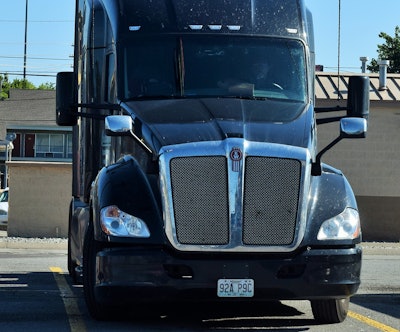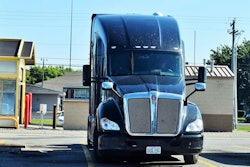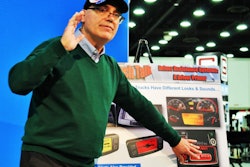I’ve had conversations with a variety of owner-operators over recent years in which a mild annoyance to outright disgust is expressed for lane-departure warning and other systems in newer-model trucks — systems which deliver feedback to the driver on movements detected or, even further, actually engage the brakes upon detection of a preset following distance.
It’s the latter situation that caught my eye upon reading a post several weeks back on the TeamRunSmart.com website by Jeff Clark, whose name will be familiar to many of you from past coverage. Clark notes a win-win situation with such active automatic braking systems on routes where an increase in following distance is possible to achieve. Such can be the most effective way to avoid persnickety over-active braking and, fringe benefit to the built-in safety-increase effect of greater following distance, increase fuel mileage at the same time.
 Owner-op and Overdrive Extra contributor Clifford Petersen, whose KW is pictured above, is among the operators who’ve spoken of learning-curve periods figuring how best to operate in tandem with a collision-mitigation system. On this unit, sensors and associated cameras in the system are positioned in the center of the bumper as well as at the center top of the windshield. If you’ve uncovered new driving techniques as a result of such systems, drop a comment below this post.
Owner-op and Overdrive Extra contributor Clifford Petersen, whose KW is pictured above, is among the operators who’ve spoken of learning-curve periods figuring how best to operate in tandem with a collision-mitigation system. On this unit, sensors and associated cameras in the system are positioned in the center of the bumper as well as at the center top of the windshield. If you’ve uncovered new driving techniques as a result of such systems, drop a comment below this post.In the system he utilizes today, Clark writes, a following distance of about 3.5 seconds seems to be where it, among others too, starts “reporting to the driver”:
If the driver is constantly pushing that 3.5-second edge, the system is more apt to engage. Generally accepted safe following distance is about 4 seconds. Try increasing your following distance to 7 seconds. At 7 seconds you won’t have to alter your speed as much. Most of the time, simply lifting the pedal, or hitting cancel cruise will suffice. You won’t have to hit the brakes as often. Think of the 4-7-second range as your MPG cushion.
Clark also lauds the efficiency of predictive cruise control that utilizes GPS for part of its functionality to help allow gravity to assist in speed management and, as any experienced driver would, for instance, “let off the accelerator just before you crest a hill and let gravity pull you down” to conserve fuel and minimize use of the brakes.
You can read his full post on the subject via this link to his Team Run Smart blog post from last month. Clark also posted a video on the subject to the Overdrive’s Trucking Pro Facebook group, where members have been getting a little more active of late since its soft launch a few months ago. You can join it yourself via this link.









